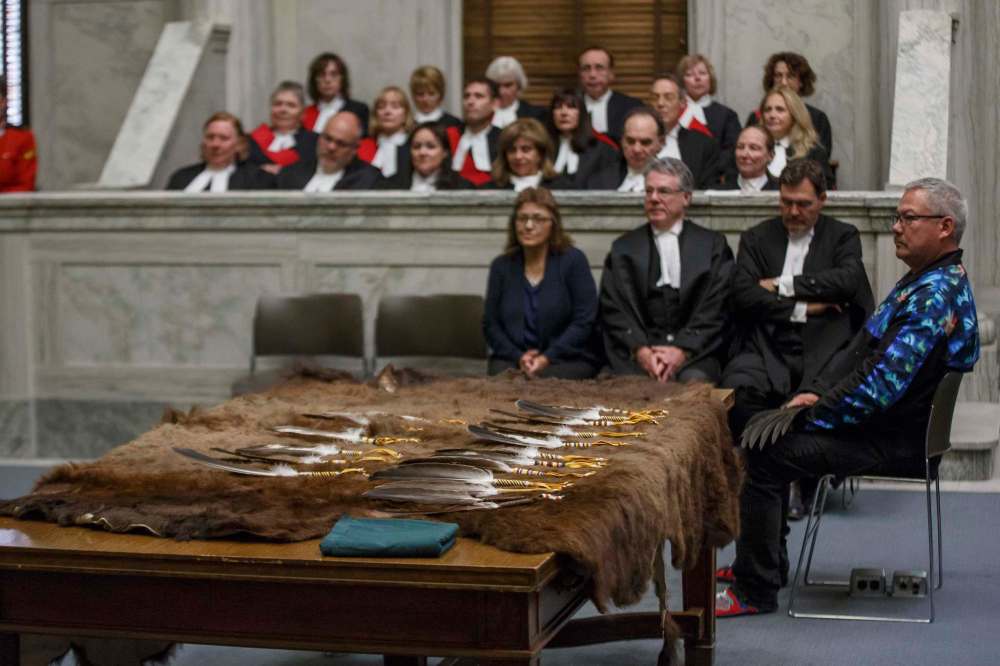Eagle feathers in law courts just small step
Read this article for free:
or
Already have an account? Log in here »
To continue reading, please subscribe:
Monthly Digital Subscription
$1 per week for 24 weeks*
- Enjoy unlimited reading on winnipegfreepress.com
- Read the E-Edition, our digital replica newspaper
- Access News Break, our award-winning app
- Play interactive puzzles
*Billed as $4 plus GST every four weeks. Offer only available to new and qualified returning subscribers. Cancel any time.
Read unlimited articles for free today:
or
Already have an account? Log in here »
Hey there, time traveller!
This article was published 27/09/2019 (1953 days ago), so information in it may no longer be current.
Forty migizii migwanag — eagle feathers — were honoured at a sunrise ceremony Thursday and later given to Manitoba justice officials for use during court proceedings. Now, for the first official time in history, anyone in a provincial court can hold a feather while testifying or swearing oaths instead of putting a hand on a Bible.
“The courts are committed to reconciliation, and the court acknowledges its responsibility to find a meaningful way to include Indigenous people in the court system and to build their confidence in the administration of justice,” said provincial court Judge Margaret Wiebe.
It’s a long time coming. The 1991 Aboriginal Justice Inquiry (AJI), for example, recommended that culturally centred practices be included and integrated throughout all elements of the justice system.

And, it’s a small gesture. The AJI also called for the creation of an Aboriginal justice system, an Aboriginal justice college, and all land claims to be settled.
So, a few dozen feathers, nearly three decades later, is really just a step, and a small step, especially considering the over-incarceration rates of Indigenous peoples. I know many in the Indigenous community who are suspicious that including a few feathers to the court system means nothing.
So, if migizii migwanag are now “an implement of justice in Manitoba,” as elder Ed Azure declared Thursday, it’s crucial we understand what this means.
The first thing is: feathers aren’t religious. In fact, there is no Indigenous “religion” one can convert to. Indigenous peoples have spirituality. Spirituality is based in the real-life knowledge, history and lives of Indigenous peoples and manifested in ceremonies, songs and stories. It’s a living tradition.
So, an eagle feather is not a Bible, it’s more like a relative you travel with and learn from.
This is why an eagle feather is not something you take or buy, but something gifted to you. Feathers are designed to build community, which is why elders say they have two sides and a spine.
That’s why you find feathers in talking circles, healing ceremonies, or at a pow-wow. Chiefs also wear them in headdresses and elders give them to future leaders.
The meaning of migizii migwan is found in its name. The word migizii refers to the megis shell, one of our most sacred Anishinaabeg teachings. Anishinaabeg have carried megis shells for a long time, from our thousand-year migration from the eastern shores of North America to our lives in and around the Great Lakes.
Just like the megis, eagles teach us about where we have been and where we are going as a people.
The second word, migwan, refers to two words: miikwan, a verb meaning to “hit the target” and mikan, “to search.” Watching eagles will demonstrate these teachings the best.

Eagles, for example, fly highest in the sky — as high as 3,000 metres (10,000 feet). They travel hundreds of square kilometres and can spot other eagles and animals up to five kilometres away. Eagles see the “big picture” while pinpointing specific, tiny spaces where food and sustenance can be found.
Eagles protect their young and are territorial, especially when parenting. Mothers lay two to four eggs and share incubation duties with their lifelong partners. Eagle parents do not kick their children out of the nest to teach them how to fly, but coax them out supportively.
“There are no flying lessons,” Anishinaabe writer Richard Wagamese describes in his 2011 book One Story, One Song. “One day the young eaglets stand at the rim of their nest with their whole world in front of them. They can hear the call of their parents high above. To fulfil their destiny and become who they were created to be, each of them must make that first frightening jump.”
An eagle knows that she cannot fly for her child, it must fly for itself.
When in conflict, eagles are fearless and tenacious. They face problems head-first and refuse to run.
So, an eagle teaches us to see the big picture and everything in it, including the needs of tomorrow’s generation. After this search, one can return home and, without fear, tell the truth of the journey.
If this doesn’t hit the target of justice I don’t know what does.
But this isn’t the only reason eagle feathers are important for justice.
“Eagle feathers are made up of thousands of tiny filaments,” Wabaseemoong Anishinaabe elder Jack Kakaway explains. “An eagle has to control them all, whether the wind is blowing or the air is still. Only that skill will keep the eagle aloft.”

Anyone who has touched a feather knows what Kakaway means. A feather is like a living being, thriving even after leaving an eagle. The oil in its spine keeps its filaments connected. When they are separated, all one has to do is gently stroke the middle spine and distribute the oils so the filaments reconnect.
When eagles experience this, such as when they get wet or in a fight, they will rub against a rock or another eagle, caring for itself. If an eagle shows enough patience and care for herself, she can fly again.
When people speak the truth, no matter how hard it is or how much it hurts, they also repair the filaments. They connect people, heal harms and create a positive path to the future.
Like the feather citizens can now hold in a Manitoba court room, people will now be able to bravely help us all come together, soar to the highest heights and see the big picture.
This is how, just maybe, migizi migwan will teach us all to fly.
Niigaan Sinclair is Anishinaabe and is a columnist at the Winnipeg Free Press.

Niigaan Sinclair
Columnist
Niigaan Sinclair is Anishinaabe and is a columnist at the Winnipeg Free Press.
Our newsroom depends on a growing audience of readers to power our journalism. If you are not a paid reader, please consider becoming a subscriber.
Our newsroom depends on its audience of readers to power our journalism. Thank you for your support.
History
Updated on Monday, September 30, 2019 12:16 AM CDT: Corrects distance eagles can see each other.









